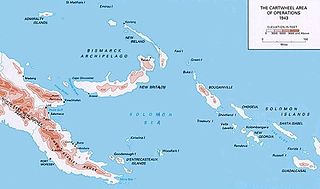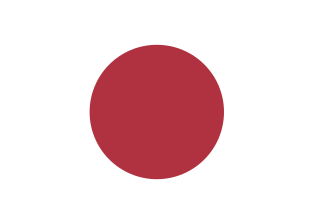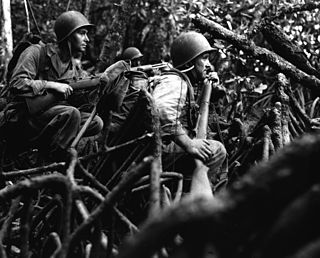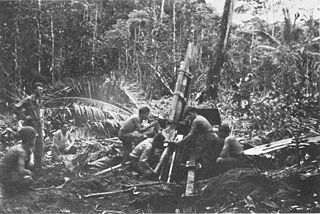 W
WThe Battle of Arundel Island was fought from 27 August – 21 September 1943, primarily between United States Army and Imperial Japanese Army forces on Arundel Island during the New Georgia campaign in the Pacific War. The battle took place towards the end of the campaign after the capture of Munda airfield and mopping up operations in western New Georgia had resulted in the Japanese evacuation of mainland New Georgia. The US high command decided to occupy the island so that it could be used as a base for artillery to fire on the main Japanese troop concentration on Kolombangara.
 W
WThe Battle of Bairoko was fought between American and Imperial Japanese Army and Navy forces on 20 July 1943 on the northern coast of New Georgia island. Taking place during World War II, it formed part of the New Georgia campaign of the Pacific War. In the battle, two battalions of the U.S. Marine Raiders from the 1st Marine Raider Regiment, supported by two U.S. Army infantry battalions attacked a Japanese garrison guarding the port of Bairoko on the Dragons Peninsula, advancing from Enogai and Triri. After a day long engagement, the Japanese repulsed the American assault and forced the attacking troops to withdraw with their wounded to Enogai. US forces remained in the area carrying out patrolling and intelligence gathering operations until the end of the campaign. Bairoko was eventually captured at the end of August after the airfield at Munda had been captured, and further reinforcements sent from there towards Bairoko to clear the area from the south.
 W
WThe Battle of Blackett Strait was a naval battle of the Pacific campaign of World War II, fought on 6 March 1943 in the Blackett Strait, between Kolombangara and Arundel Island in the Solomon Islands. The battle was a chance encounter between two Japanese destroyers that had been undertaking a resupply run to Vila and a U.S. Navy force of three light cruisers and three destroyers that had been tasked with bombarding the Japanese shore facilities around Vila. The two forces clashed as the Japanese destroyers were withdrawing through the Kula Gulf. In the short battle that followed the two Japanese destroyers were sunk after which the U.S. ships completed their bombardment of Vila before returning to their base.
 W
WThe Battle of Cape St. George was a naval battle of the Pacific campaign of World War II fought on 25 November 1943, between Cape St. George, New Ireland, and Buka Island. It was the last engagement of surface ships in the Solomon Islands campaign. During the engagement, a force of five US Navy destroyers led by Captain Arleigh Burke intercepted a similar sized Japanese force that was withdrawing from Buka towards Rabaul, having landed reinforcements on the island. In the ensuing fight, three Japanese destroyers were sunk and one was damaged, with no losses amongst the US forces.
 W
WThe Battle of Kolombangara was a naval battle of the Pacific campaign of World War II, fought on the night of 12/13 July 1943, off the northeastern coast of Kolombangara in the Solomon Islands. The battle took place during the early stages of the New Georgia campaign when an Imperial Japanese Navy force, carrying reinforcements south to Vila, Solomon Islands, was intercepted by a task force of U.S. and New Zealand light cruisers and destroyers. In the ensuing action, the Japanese sunk one Allied destroyer and damaged three cruisers. They were also able to successfully land 1,200 ground troops on the western coast of Kolombangara but lost one light cruiser sunk with all hands in the process.
 W
WThe naval Battle of Kula Gulf took place in the early hours of 6 July 1943 during World War II. The battle involved United States and Japanese ships off the eastern coast of Kolombangara in the Solomon Islands. It took place during the early stages of the New Georgia campaign when a Japanese force landing reinforcements at Vila was intercepted by a force of US Navy cruisers and destroyers. One US light cruiser was sunk during the engagement while two Japanese destroyers were sunk and two more were damaged. The Japanese withdrew after the engagement, having landed 1,600 troops.
 W
WThe Battle of Vella Lavella was a naval battle of the Pacific campaign of World War II fought on the night of 6 October 1943, near the island of Vella Lavella in the Solomon Islands. It marked the end of a three month fight to capture the central Solomon Islands, as part of the Solomon Islands Campaign.
 W
WThe Battle off Horaniu was a minor naval battle of the Pacific campaign of World War II, fought near Vella Lavella, in the Solomon Islands. On the night of 17–18 August 1943, four U.S. Navy destroyers intercepted an Imperial Japanese Navy convoy carrying troops to Horaniu, on the northern coast of Vella Lavella, where they were to establish a barge base to support the movement of troops through the region.
 W
WOperation Cartwheel (1943–1944) was a major military operation for the Allies in the Pacific theatre of World War II. Cartwheel was an operation aimed at neutralising the major Japanese base at Rabaul. The operation was directed by the Supreme Allied Commander in the South West Pacific Area (SWPA), General Douglas MacArthur, whose forces had advanced along the northeast coast of New Guinea and occupied nearby islands. Allied forces from the South Pacific Area, under Admiral William Halsey, advanced through the Solomon Islands toward Bougainville. The Allied forces involved were from Australia, the Netherlands, New Zealand, the US and various Pacific Islands.
 W
WThe Battle of Enogai was a battle between United States and Imperial Japanese Army and Navy forces on 10–11 July 1943. It took place in the early phase of the New Georgia Campaign in the Solomon Islands during the Pacific War. Prior to the battle, US troops had landed at Rice Anchorage, in the Kula Gulf, on the northern coast of New Georgia, tasked with supporting efforts further south to advance on the airfield at Munda.
 W
WThe Guadalcanal campaign, also known as the Battle of Guadalcanal and codenamed Operation Watchtower by American forces, was a military campaign fought between 7 August 1942 and 9 February 1943 on and around the island of Guadalcanal in the Pacific theater of World War II. It was the first major land offensive by Allied forces against the Empire of Japan.
 W
WOperation I-Go was an aerial counter-offensive launched by Imperial Japanese forces against Allied forces during the Solomon Islands and New Guinea Campaigns in the Pacific Theater of World War II. Taking place from 1–16 April 1943, during the operation, Japanese aircraft – primarily from Imperial Japanese Navy units under the command of Admirals Isoroku Yamamoto and Jinichi Kusaka – attacked Allied ships, aircraft, and land installations in the southeast Solomon Islands and New Guinea. The goal of the operation was to halt the Allied offensives in New Guinea and the Solomons and to give Japan time to prepare a new set of defenses in response to recent defeats to the Allies in the Battle of Guadalcanal and in New Guinea at Buna–Gona, Wau, and the Bismarck Sea.
 W
WThe Japanese occupation of the Solomon Islands was the period in the history of the Solomon Islands between 1942 and 1945 when Imperial Japanese forces occupied Solomon Islands during World War II.
 W
WOperation Ke was the largely successful withdrawal of Japanese forces from Guadalcanal, concluding the Guadalcanal Campaign of World War II. The operation took place between 14 January and 7 February 1943, and involved both Imperial Japanese Army (IJA) and Imperial Japanese Navy (IJN) forces under the overall direction of the Japanese Imperial General Headquarters (IGH). Commanders of the operation included Isoroku Yamamoto and Hitoshi Imamura.
 W
WThe Landings on Rendova were amphibious military assaults by United States Army, Marine Corps and Navy forces on Rendova Island in the Solomon Islands on 30 June 1943. The small Japanese garrison was quickly overwhelmed by US troops, but the island was subjected to heavy attack by Japanese aircraft over several days. The landings were some of the first Allied landings during the New Georgia Campaign of the Pacific War and were successful in securing the island and providing a base from which the Allies could support the subsequent invasion of New Georgia island and the eventual capture of Munda airfield in early August 1943.
 W
WThe Battle of Mount Austen, the Galloping Horse, and the Sea Horse, part of which is sometimes called the Battle of the Gifu, took place from 15 December 1942 to 23 January 1943 and was primarily an engagement between United States and Imperial Japanese forces in the hills near the Matanikau River area on Guadalcanal during the Guadalcanal Campaign. The U.S. forces were under the overall command of Alexander Patch and the Japanese forces were under the overall command of Harukichi Hyakutake.
 W
WThe Battle of Munda Point was a battle, from 22 July – 5 August 1943, between primarily United States Army and Imperial Japanese Army forces during the New Georgia Campaign in the Solomon Islands in the Pacific War. The battle took place following a landing by U.S. troops on the western coast of New Georgia from Rendova, as part of an effort to capture the Japanese airfield that had been constructed at Munda Point. This advance had become bogged down and while the Allies brought forward reinforcements and supplies, the Japanese had launched a counterattack on 17–18 July. This effort was ultimately unsuccessful and afterwards U.S. forces launched a corps-level assault to reinvigorate their effort to capture the airfield. Against this drive, Japanese defenders from three infantry regiments offered stubborn resistance, but were ultimately forced to withdraw, allowing U.S. forces to capture the airfield on 5 August. The airfield later played an important role in supporting the Allied campaign on Bougainville in late 1943.
 W
WThe Drive on Munda Point was an offensive by mainly United States Army forces against Imperial Japanese forces on New Georgia in the Solomon Islands from 2–17 July 1943. The Japanese forces, mainly from the Imperial Japanese Army, were guarding an airfield at Munda Point on the western coast of the island that the U.S. wished to capture as one of the key objectives of the New Georgia campaign. After landing around Zanana on 2 July from Rendova, U.S. troops began a westward advance towards the airfield at Munda. Held up by difficult terrain and stubborn Japanese defense, elements of three U.S. regiments advanced slowly along the Munda trail over the course of two weeks. The slow progress resulted in a reorganization of the U.S. forces assigned to the drive, and preparations were made for a corps-level offensive, but before this could be launched, the Japanese launched a counterattack on 17 July.
 W
WThe New Georgia campaign was a series of land and naval battles of the Pacific campaign of World War II between Allied forces and the Empire of Japan. It was part of Operation Cartwheel, the Allied strategy in the South Pacific to isolate the Japanese base around Rabaul. The campaign took place in the New Georgia group of islands, in the central Solomon Islands and followed the Allied capture of the Russell Islands. The main fighting took place on New Georgia island itself, although significant actions also took place around the island chain throughout the campaign.
 W
WThe New Georgia counterattack was a counterattack on 17–18 July 1943 by mainly Imperial Japanese Army troops against United States Army forces during the New Georgia campaign in the Solomon Islands. The U.S. and its allies were attempting to capture an airfield constructed by the Japanese at Munda Point on New Georgia with which to support further advances towards the main Japanese base around Rabaul as part of Operation Cartwheel.
 W
WThe Raid on Choiseul was a small unit engagement that occurred from October 28 to November 3, 1943, during the Solomon Islands campaign, and was launched to divert Japanese from the Allied landings at Cape Torokina, on Bougainville Island. During the raid, United States Marines from the 2nd Parachute Battalion, landed on Japanese occupied Choiseul in the northern Solomon Islands and carried out raids on Japanese army and navy forces over a 25-mile (40 km) area over the course of seven days with the assistance of local Choiseul islanders and an Australian coastwatcher. The force was withdrawn back to Vella Lavella by landing craft following the successful lodgment of US troops on Bougainville.
 W
WThe Battle of Rennell Island took place on 29–30 January 1943. It was the last major naval engagement between the United States Navy and the Imperial Japanese Navy during the Guadalcanal Campaign of World War II. It occurred in the South Pacific between Rennell Island and Guadalcanal in the southern Solomon Islands.
 W
WThe Solomon Islands campaign was a major campaign of the Pacific War of World War II. The campaign began with Japanese landings and occupation of several areas in the British Solomon Islands and Bougainville, in the Territory of New Guinea, during the first six months of 1942. The Japanese occupied these locations and began the construction of several naval and air bases with the goals of protecting the flank of the Japanese offensive in New Guinea, establishing a security barrier for the major Japanese base at Rabaul on New Britain, and providing bases for interdicting supply lines between the Allied powers of the United States and Australia and New Zealand.
 W
WThe Battle of the Treasury Islands was a Second World War battle that took place between 27 October and 12 November 1943 on the Treasury Islands group, part of the Solomon Islands. The battle formed part of the wider Pacific War and involved New Zealand and US forces fighting against Japanese troops. The majority of the ground forces were provided by the New Zealand 3rd Division.
 W
WThe Battle of Vella Gulf was a naval battle of the Pacific campaign of World War II fought on the night of 6–7 August 1943 in Vella Gulf between Vella Lavella Island and Kolombangara Island in the Solomon Islands of the Southwest Pacific.
 W
WThe Battle of Vella Lavella was fought from 15 August – 6 October 1943 between Japan and the Allied forces from New Zealand and the United States at the end of the New Georgia campaign. Vella Lavella, an island located in the Solomon Islands, had been occupied by Japanese forces early during the war in the Pacific. Following the fighting around Munda Point, the Allies recaptured the island in late 1943, following a decision to bypass a large concentration of Japanese troops on the island of Kolombangara.
 W
WOperation Vengeance was the American military operation to kill Admiral Isoroku Yamamoto of the Imperial Japanese Navy on April 18, 1943, during the Solomon Islands campaign in the Pacific Theater of World War II. Yamamoto, commander of the Combined Fleet of the Imperial Japanese Navy, was killed on Bougainville Island when his transport bomber aircraft was shot down by United States Army Air Forces fighter aircraft operating from Kukum Field on Guadalcanal.
 W
WThe Battle of Viru Harbor was a battle of the Pacific campaign of World War II that took place on New Georgia island during the New Georgia Campaign from 28 June – 1 July 1943. It was one of the first actions of the campaign and involved an overland advance by elements of a Marine Raider battalion, supported by a United States Army infantry company. Supported by airstrikes, the Marines carried out an enveloping attack on the Japanese defenders around the harbor and forced them to withdraw. The harbor was subsequently used by US forces to support further operations, although plans to build a PT boat base in the area were later canceled when the harbor was found to be unsuitable.
 W
WThe Battle of Wickham Anchorage took place during the New Georgia campaign in the Solomon Islands during the Pacific War from 30 June – 3 July 1943. During the operation US Marines and US Army troops landed by ship around Oleana Bay on Vangunu Island and advanced overland towards the anchorage where they attacked a garrison of Imperial Japanese Navy and Army troops. The purpose of the attack by the U.S. was to secure the lines of communication and supply between Allied forces involved in the New Georgia campaign and Allied bases in the southern Solomons. The U.S. forces were successful in driving the Japanese garrison from the area and securing the anchorage, which would later be used to stage landing craft for subsequent operations.